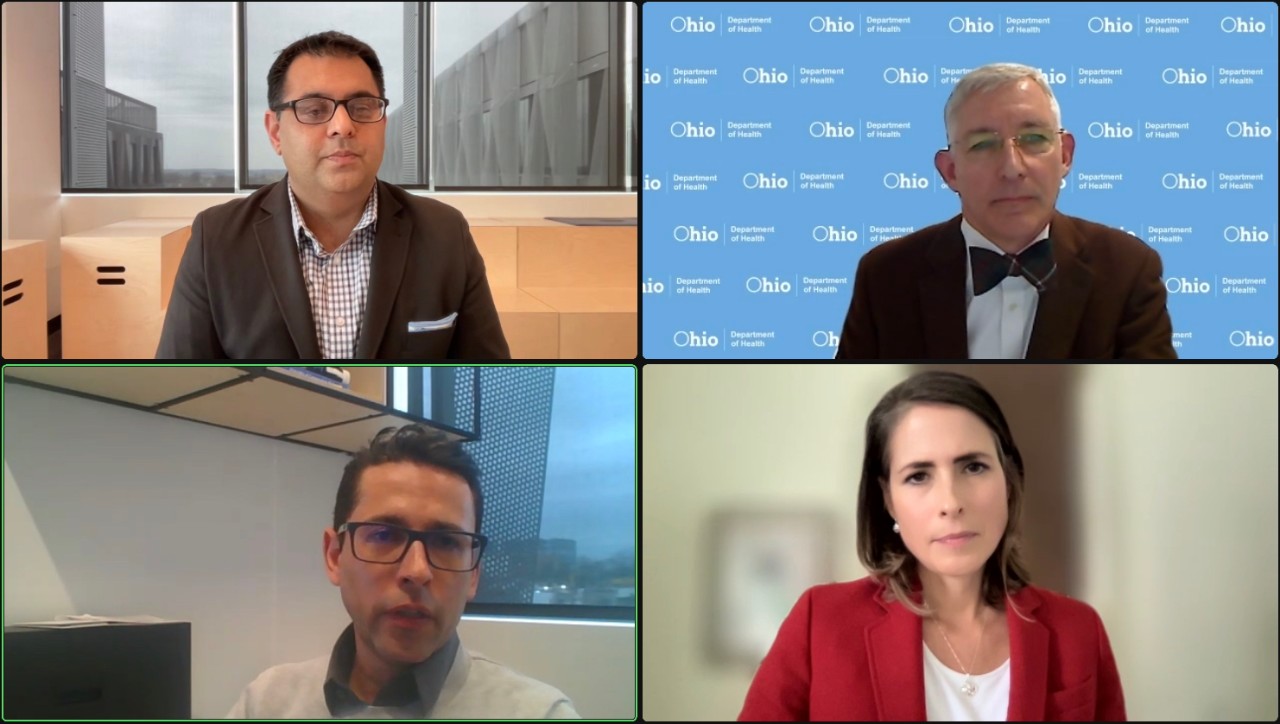
UC research helps identify vulnerable populations
Flashpoint Series explores how Ohio is addressing health care disparities
Research from the University of Cincinnati is helping to expose the health disparities that negatively affect Ohioans in poorer communities, both urban and rural, and guiding solutions to offer better care.
UC’s Office of Research hosted a panel discussion in the Digital Futures Flashpoint Series, “Overcoming Disparities in Health Care,” which addressed the challenges millions of Ohioans face every day and what is working to address them.
“We don't believe that your zip code should dictate your health, and far too frequently it's a huge factor,” said Cara Dingus Brook, president and CEO of the Foundation for Appalachian Ohio, a regional community foundation serving Ohio’s 32 counties in Appalachia with the mission to create opportunities for Appalachian Ohio’s citizens and communities.
Along with Brook, the panel discussion included Diego Cuadros, PhD, an associate professor of geography and digital epidemiology lab leader in UC’s Digital Futures, and Bruce Vanderhoff, MD, director of the Ohio Department of Health. The discussion was led by moderator Jai Chabria, managing director at MAD Global Strategy, a public affairs firm now with an office in Columbus, Ohio.

Clockwise from left, Jai Chabria, managing director at MAD Global Strategy, a public affairs firm; Bruce Vanderhoff, MD, director of the Ohio Department of Health; Cara Dingus Brook, president and CEO of the Foundation for Appalachian Ohio; and Diego Cuadros, PhD, an associate professor of geography and digital epidemiology lab leader in the University of Cincinnati’s Digital Futures. Photo/UC Digital Futures
In Ohio's Appalachian counties, life expectancy can be 10 years shorter than across the rest of the state, Brook said. The region's lower life expectancy can be attributed to factors including:
- A 22% higher heart disease mortality
- A 15% higher cancer mortality
- Higher rates of drug overdoses, depression and suicide
- Fewer people with medical insurance
Primary care deserts
Also negatively affecting Appalachia and other rural areas, Vanderhoff said, is a shortage of medical providers.
- In the United States, on average in urban areas, there is one primary care provider for approximately every 1,500 residents.
- In rural areas, there is one primary care provider for approximately every 3,000 residents.
- In Ohio's Appalachian counties, there is one primary care provider for approximately every 3,500 residents.
While cities have more primary care providers, that care isn't distributed evenly, Vanderhoff said. Thus, within urban areas, there are communities that lack access to primary care, similar to the issues faced in rural regions.
“If we look at our urban areas, the problem is, while we have a lot of providers, we have urban provider deserts. The provider population is just not distributed evenly,” Vanderhoff said. “We actually have a very similar challenge in health care delivery if we look at those urban deserts that we also see in some of our rural areas.”
Access to health care
During the COVID-19 pandemic, the lack of health care infrastructure was evident in communities across Ohio, Cuadros said.
While many people attributed lower vaccination rates in rural communities purely to vaccine hesitancy, Cuadros' data analysis revealed a correlation between a lack of health care infrastructure and lower vaccination rates.
“We found counties with a lower health care infrastructure were also counties with lower vaccination uptake, and more than 80% of those low vaccination counties were rural,” the UC researcher said. “It was a very interesting indicator of potentially a lack of infrastructure and access to care.”
Reaching vulnerable populations
To reduce health care disparities, the Ohio Department of Health has increased focus on programs that reach vulnerable populations in their communities.
The state deployed six mobile vaccination vans during the pandemic that visited 128 locations throughout Ohio, including grocery store parking lots in urban areas and fairgrounds in rural areas. The mobile units distributed 2,300 COVID-19 vaccines and also provided health screenings.
Ohio also is reaching vulnerable populations by establishing school-based health programs. The programs essentially are primary care branch offices operating out of schools that provide care for students and their families.
“The place in so many communities, whether they're urban or rural, that is a real integrated part of nearly every community, feels safe to the members of that community and has real broad contact with both children and their families are our schools,” Vanderhoff said.
Also, Ohio has established an Emergency Department Comprehensive Care program, an effort to increase screenings and harm reduction efforts within hospital emergency departments following opioid overdoses. At 27 emergency departments across the state, almost 250,000 people with opioid use disorder have been connected to clinical care and other services.
“This really is a level-setting opportunity for us to reach so many communities and do it at a time we know our impact is more likely to result in people making the choice to enter into recovery,” Vanderhoff said.
Identifying vulnerable areas
To best deploy resources, it's important to understand where assistance is most needed and who most needs it, UC's Cuadros said.
Using data analysis and visualizations, Cuadros is better able to understand the dynamics of issues such as the COVID-19 pandemic and opioid crisis.
By identifying hot spots, intervention measures can be directed to those communities.
Data also can help uncover barriers that could prevent people from accessing care.
While telemedicine could help people in communities that lack health care infrastructure, those communities often lack other infrastructure as well such as high-speed internet.
“It's very important before we expand services we really understand how it works and what kind of barriers we're going to face before we aggressively expand this kind of technology,” Cuadros said. “We want to produce a solution for these disparities, but maybe these kinds of solutions could actually exacerbate these disparities.”
Featured image at top courtesy of Unsplash.
Next Lives Here
The University of Cincinnati is classified as a Research 1 institution by the Carnegie Commission and is ranked in the National Science Foundation's Top-35 public research universities. UC's medical, graduate and undergraduate students and faculty investigate problems and innovate solutions with real-world impact. Next Lives Here.
Related Stories
UC research helps identify vulnerable populations
February 10, 2023
Research from the University of Cincinnati is helping to expose the health disparities that negatively affect Ohioans in poorer communities, both urban and rural, and guiding solutions to offer better care.
WCPO: UC-backed startup aims to use AI to detect heart disease
March 4, 2024
A University of Cincinnati-backed startup is developing explainable artificial intelligence to better diagnose coronary artery disease risk in women, WCPO reported.
Spectrum News: UC-backed startup hopes to save lives with AI
April 4, 2024
By combining existing mammograms with its artificial intelligence, a University of Cincinnati-backed startup hopes to detect heart disease and save lives, Spectrum News reported.
